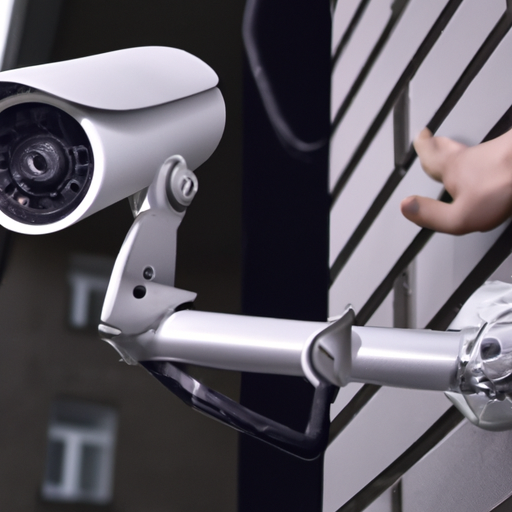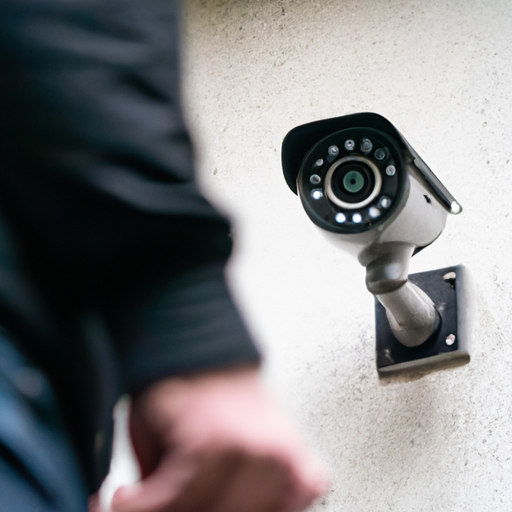
In this article, we will discuss the essential features you should consider when buying a home security camera. You will learn about the importance of image quality, night vision capabilities, and motion detection. Additionally, we will cover the significance of remote viewing and storage options, ensuring you can monitor your home from anywhere. So, let’s dive into the world of home security cameras and make an informed decision to protect your home and loved ones. When it comes to choosing a home security camera, there are several important features to consider. The right camera can provide you with peace of mind and added security for your home and loved ones. In this article, we will explore the key features you should look for when purchasing a home security camera.
This image is property of images.unsplash.com.
Image Quality
The first feature to consider is the image quality of the camera. After all, the purpose of a security camera is to capture clear and detailed footage. One important aspect of image quality is the resolution. Look for cameras that offer high-resolution video, such as 1080p or even 4K, to ensure that you can see every detail clearly.
In addition to resolution, consider the low light performance of the camera. Many security incidents occur at night or in low light conditions, so it is crucial that your camera can capture clear footage in these situations. Look for cameras with features such as infrared night vision or low-light sensors to ensure optimal performance in any lighting conditions.
Lastly, consider the field of view offered by the camera. A wider field of view means that the camera can cover a larger area, reducing the number of cameras needed to monitor your home. Look for cameras with a wide-angle lens or a pan-tilt-zoom (PTZ) feature that allows you to control the direction and zoom of the camera remotely.
Recording Options
Another important feature to consider is the recording options provided by the camera. There are typically two types of storage options available: cloud storage and local storage.
Cloud storage allows you to store your camera’s footage securely in the cloud. This option provides easy access to your recordings from anywhere with an internet connection and eliminates the risk of losing your footage if the camera is damaged or stolen. However, be aware that some cloud storage plans may require a subscription fee.
On the other hand, local storage involves saving the footage directly to a storage device, such as a microSD card or a network-attached storage (NAS) device. This option can save you money on monthly subscription fees, but it may require more maintenance and manual management of the storage device.
Additionally, consider whether the camera offers continuous recording or only records when motion is detected. Continuous recording allows you to capture every moment, but it may require larger storage capacity. Motion detection recording, on the other hand, saves storage space by only recording when something is happening in the camera’s field of view.
This image is property of images.unsplash.com.
Connectivity
The connectivity options of the camera are also important to consider. Most modern security cameras offer wireless connectivity, allowing you to connect the camera to your home Wi-Fi network. This wireless connection provides flexibility in camera placement and makes it easier to install the camera without the need for complicated wiring.
However, if you prefer a more stable and reliable connection, you may opt for a wired camera. Wired cameras require an Ethernet cable to connect to your home network and power source. While this may require more effort during installation, it ensures a steady connection and eliminates the risk of signal interference.
Additionally, consider whether the camera offers mobile app access. A mobile app allows you to access the camera’s live feed, recorded footage, and settings from your smartphone or tablet. This feature provides convenient and on-the-go access to your camera’s surveillance.
Motion Detection
Motion detection is an essential feature of any home security camera. It allows the camera to automatically start recording when motion is detected, alerting you to potential intruders or suspicious activity. When considering motion detection, there are a few features to look for.
Firstly, consider the sensitivity levels of the camera’s motion detection. Different cameras offer varying levels of sensitivity, allowing you to customize how easily the camera is triggered by motion. This feature can be particularly useful if you live in a high-traffic area or have pets that may trigger false alarms.
Secondly, consider the zone customization feature. This feature allows you to define specific areas in the camera’s field of view where motion detection should be active. For example, you may want to exclude certain areas like a tree that constantly moves with the wind. By customizing the motion detection zones, you can reduce false alarms and focus on the areas that require the most attention.
Lastly, consider whether the camera offers real-time alerts. Real-time alerts send notifications to your smartphone or other devices when motion is detected, allowing you to take immediate action. This feature can be particularly useful if you are away from home and want to be alerted of any potential security issues.
This image is property of images.unsplash.com.
Installation
When it comes to installation, there are a few factors to consider. Firstly, decide whether you want to undertake a DIY installation or hire a professional. DIY installation is typically more cost-effective and allows you to have full control over the setup and placement of the camera. However, it may require some technical skills and may take more time to complete.
On the other hand, professional installation ensures that the camera is correctly installed and set up for optimal performance. It may also come with additional support and warranty from the installation provider. However, professional installation can be more expensive and may require scheduling an appointment.
Additionally, consider whether you need indoor or outdoor cameras. Indoor cameras are designed to be used indoors and may not be weatherproof or have certain features necessary for outdoor use, such as infrared night vision. Outdoor cameras, on the other hand, are built to withstand the elements and provide surveillance for the exterior of your home.
Lastly, consider the mounting options provided by the camera. Some cameras can be mounted on walls or ceilings using screws or brackets, while others may come with a magnetic base or a stand for tabletop placement. Choose a mounting option that suits your needs and allows for optimal camera placement.
Night Vision
Night vision is a crucial feature for any home security camera. It allows the camera to capture clear footage even in complete darkness. When considering night vision, there are a few factors to keep in mind.
Firstly, consider the type of night vision offered by the camera. Most security cameras use infrared (IR) illumination to provide night vision. IR illuminators emit infrared light that is invisible to the human eye but can be detected by the camera’s sensors, allowing it to capture clear footage in the dark.
Secondly, consider the range of the camera’s night vision. The range refers to how far the camera’s night vision can reach. A longer range allows the camera to capture clear footage of objects or people that are farther away from the camera. Consider your specific surveillance needs and choose a camera with an appropriate night vision range.
Lastly, consider whether the camera offers invisible IR. Invisible IR refers to night vision that does not emit a visible red glow that can potentially alert intruders to the presence of the camera. This feature can be particularly useful if you want to maintain a discreet surveillance setup.

Two-Way Audio
Two-way audio is a feature that allows you to listen and speak through the camera. It can be particularly useful for communication purposes or to deter potential intruders. When considering two-way audio, there are a few features to look for.
Firstly, consider whether the camera has a built-in microphone. The microphone allows you to listen to what is happening near the camera. This feature can be useful for monitoring conversations or detecting unusual sounds.
Secondly, consider whether the camera has a speaker. The speaker allows you to speak through the camera, effectively communicating with anyone near the camera. This feature can be useful for giving instructions, scaring off intruders, or even just talking to family members or pets.
Lastly, consider whether the camera offers noise cancellation. Noise cancellation technology helps filter out background noise and improves the clarity of the audio. This feature ensures that your voice is clear and intelligible, even in noisy environments.
Remote Viewing
Remote viewing is an essential feature of any home security camera. It allows you to access the camera’s live feed and recorded footage remotely, providing you with constant surveillance and peace of mind. When considering remote viewing, there are a few features to keep in mind.
Firstly, consider whether the camera offers live streaming. Live streaming allows you to view the camera’s live feed in real-time, providing you with up-to-date surveillance. This feature can be particularly useful if you want to keep an eye on your home while you are away or monitor ongoing events.
Secondly, consider whether the camera offers playback access. Playback access allows you to view the camera’s recorded footage, either continuously or based on motion detection events. This feature can be useful for reviewing past events or incidents, providing additional evidence or insights.
Lastly, consider the multiple devices compatibility of the camera. Look for cameras that offer support for multiple platforms, such as smartphones, tablets, or computers. This allows you to access the camera’s surveillance from different devices and ensures compatibility with your existing technology ecosystem.

Smart Home Integration
Smart home integration is a feature that allows your security camera to work seamlessly with other smart devices in your home. It can provide additional convenience and automation to your security setup. When considering smart home integration, there are a few platforms to look out for.
Firstly, consider whether the camera is compatible with Amazon Alexa. Amazon Alexa is a popular virtual assistant that can control various smart home devices using voice commands. Integration with Alexa allows you to control your security camera hands-free, such as asking Alexa to show you the camera’s live feed on compatible devices.
Secondly, consider whether the camera is compatible with Google Assistant. Google Assistant is another virtual assistant that can control smart home devices. Integration with Google Assistant allows you to control your security camera using voice commands or through the Google Home app.
Lastly, consider whether the camera supports IFTTT (If This, Then That). IFTTT is a platform that allows you to create custom automations between different smart devices and services. Integration with IFTTT expands the capabilities of your security camera, allowing it to interact with other smart devices or trigger actions based on specific events or conditions.
Conclusion
Choosing the right home security camera is an important decision, as it can greatly enhance the safety and security of your home. By considering the features discussed in this article, such as image quality, recording options, connectivity, motion detection, installation, night vision, two-way audio, remote viewing, and smart home integration, you can make an informed choice that meets your specific needs.
Remember to thoroughly research and compare different camera models and brands to find the one that best suits your requirements and budget. Whether you opt for a DIY installation or professional setup, having a home security camera in place can provide you with invaluable peace of mind knowing that your home and loved ones are protected.


